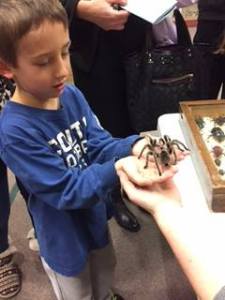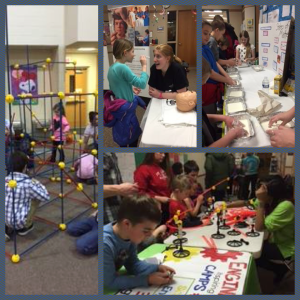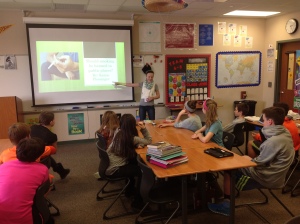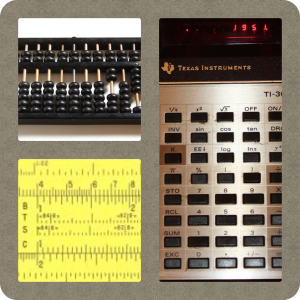How does a first grade class come to understand literally how big a bald eagle’s nest really is? Build a nest in the classroom, of course!
If you’ve been following HSE21 Shorts, you’ll know that Mrs. Vogel’s first grade class at Sand Creek Elementary began watching the Southwest Florida Eagle Cam in December 2016, right as eaglet E-9 was making his/her entry to the world. Watching the Eagle Cam led to lots of eagle questions – which led to research, the creation of some very authentic projects, and the sharing of learning!
How did the project unfold? The class spent several days observing and monitoring the nest – as questions arose, the students wrote them on post-it notes. With Mrs. Vogel’s help, the class categorized their post-its and created four research groups. Each student joined a group and became an expert on one area of eagle life. The students consulted library books, digital resources (like World Book Online), and even visited with experts from the Indianapolis Zoo via Skype to find reliable answers to their research questions.
HSE21 Shorts was thrilled to receive this invitation recently from Mrs. Vogel:
We have been researching and creating and are ready to share our learning. We
have a life sized nest, 3D models, a video, and much more! On Friday we are hosting
an open house for classes to come and see our project and learn about eagles.
Check out the image gallery and video below of eagle projects and scenes from this awesome open house of learning. Mrs. Vogel’s students shared with kindergarteners and fourth graders, with administrators, parents, and teachers. All the while, of course, E-9 was on the big screen. As of this writing, E-9 has gone from a fuzz ball to feathered bird and is growing fast! He’s testing out his wings often, and should be fledging very soon. You, too, can live stream the Southwest Florida Eagle Cam here.
Thanks to the students who have taught HSE21 Shorts a great deal about bald eagles! First graders CAN, and DO!













































![IMG_7897[1]](https://hse21shorts.files.wordpress.com/2014/12/img_78971.jpg?w=202&h=268) HSE Freshman Campus English teacher Jen Torres’ class has focused on heroes this fall. Throughout the semester, Torres’ students read books of their choice about persons who could be classified as heroes. The freshmen also researched in depth to learn more about the lives of their heroes, in order to answer the driving question, What makes a hero? Are heroes born? Did something in a hero’s childhood build heroic character? Or…do heroes just make wise choices at pivotal times?
HSE Freshman Campus English teacher Jen Torres’ class has focused on heroes this fall. Throughout the semester, Torres’ students read books of their choice about persons who could be classified as heroes. The freshmen also researched in depth to learn more about the lives of their heroes, in order to answer the driving question, What makes a hero? Are heroes born? Did something in a hero’s childhood build heroic character? Or…do heroes just make wise choices at pivotal times? ek, the ninth graders’ hero study culminated with a Hero Fair in the school media center. Students used a variety of presentation tools and methods to share their learning with peers, school administrators, and other teachers. Many discoveries about heroes were shared; among others, students realized that heroes can definitely reside close to home! L
ek, the ninth graders’ hero study culminated with a Hero Fair in the school media center. Students used a variety of presentation tools and methods to share their learning with peers, school administrators, and other teachers. Many discoveries about heroes were shared; among others, students realized that heroes can definitely reside close to home! L
![IMG_7896[1]](https://hse21shorts.files.wordpress.com/2014/12/img_78961.jpg?w=132&h=177) The theme of ‘heroes’ clearly had an impact on Ms. Torres’ students. Through reading, writing, speaking, listening, designing, and pondering, the ninth graders all took away a deeper understanding of what heroism really means.
The theme of ‘heroes’ clearly had an impact on Ms. Torres’ students. Through reading, writing, speaking, listening, designing, and pondering, the ninth graders all took away a deeper understanding of what heroism really means. on a time there was the abacus. Then the slide rule. By the time I entered high school, handy multi-function calculators were all the rage (pictured at left is a TI-30, circa 1976). Calculating machines, like other technological tools, have slowly become more sophisticated.
on a time there was the abacus. Then the slide rule. By the time I entered high school, handy multi-function calculators were all the rage (pictured at left is a TI-30, circa 1976). Calculating machines, like other technological tools, have slowly become more sophisticated. Slowly, that is, until the computer age took hold. Today’s calculators are no less than specialized mini-computers, designed to assist scientists–and students–in performing complex calculations and solving mathematical and scientific problems. What’s more, these calculating ‘systems’ can easily be networked, making the once silent, straight-rowed math class an interactive, responsive mathematics lab! Take a one-minute peek into Kathleen Robeson’s room at Fishers High School to see how TI-NspireTM calculators and the CX Navigator SystemTM combined with the leadership of an excellent teacher, have transformed instruction.
Slowly, that is, until the computer age took hold. Today’s calculators are no less than specialized mini-computers, designed to assist scientists–and students–in performing complex calculations and solving mathematical and scientific problems. What’s more, these calculating ‘systems’ can easily be networked, making the once silent, straight-rowed math class an interactive, responsive mathematics lab! Take a one-minute peek into Kathleen Robeson’s room at Fishers High School to see how TI-NspireTM calculators and the CX Navigator SystemTM combined with the leadership of an excellent teacher, have transformed instruction.


 children are naturals when it comes to creation and design. Catapults, rockets, roller coasters…just mention these words, and creative constructions are not far behind! Sand Creek Elementary recently provided a wonderful opportunity for budding engineers and designers to explore science, technology, engineering, and mathematics (STEM). The event, known as Family Engineering Night, brought together over two-hundred-and-fifty members of the SCE community.
children are naturals when it comes to creation and design. Catapults, rockets, roller coasters…just mention these words, and creative constructions are not far behind! Sand Creek Elementary recently provided a wonderful opportunity for budding engineers and designers to explore science, technology, engineering, and mathematics (STEM). The event, known as Family Engineering Night, brought together over two-hundred-and-fifty members of the SCE community. 
![FullSizeRender[1]](https://hse21shorts.files.wordpress.com/2014/11/fullsizerender11.jpg?w=224&h=227)
![FullSizeRender[1]](https://hse21shorts.files.wordpress.com/2014/11/fullsizerender11.jpg?w=223&h=226)



